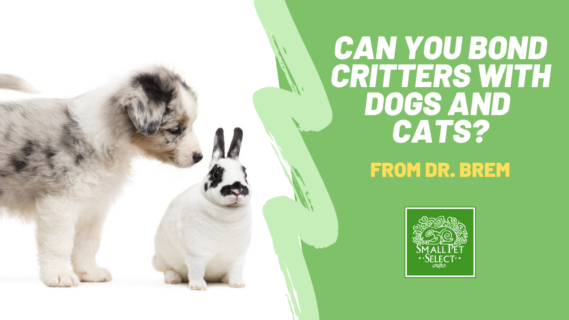When my husband and I met, he had a dog, Rylynn, and I had five rabbits. I wasn’t sure if we could all ever become a family (critters with dogs?!).
I had had a lot of experience bonding rabbits with other rabbits but with a dog? Fortunately, with a little time and patience (and a good combination of personalities, the humans included), the dog and bunnies eventually saw each other as family members.
Are you hoping to bond your critter with a cat or dog? I hope this blog can help!
The Right Combination
There are obvious possible dangers with dogs or cats and small pets sharing a home. These range from purposeful injuries stemming from the fact that dogs and cats are natural predators and most critters are natural prey to accidental injuries from “playing” with each other to fear.
These dangers can often be lessened when you have the right combination of critter and dog or cat. Breed can be a factor. For example, dogs who have been bred for hunting, such as terriers, sighthounds, and scent hounds, may not be the best for having critters with dogs. Size can also be a factor.
For example, a larger breed rabbit and a smaller breed dog or cat may work out better. Sometimes introducing a critter to a puppy or kitten rather than an adult animal can be the easiest.
With that said, however, we got our dog Soda as a puppy, and while she initially ignored the rabbits, within several weeks she began to be a little too interested.
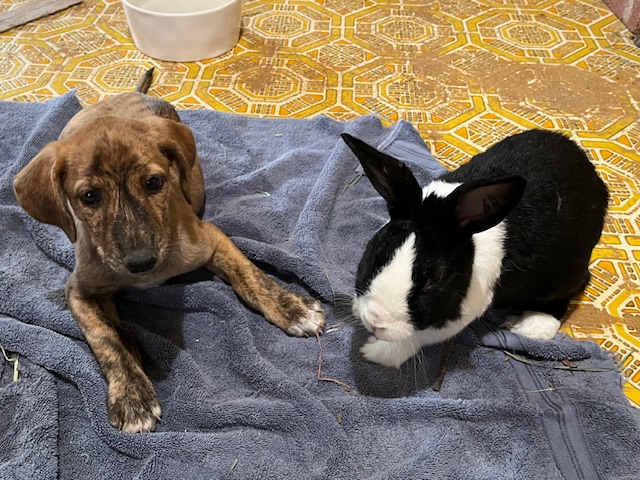
Soda the puppy initially did not bother Silver or the other rabbits, but as she got older her prey drive started to kick in. Currently, they get along through a barrier. Photographer: Amy “Brem” Bremers.
The most important thing when it comes to critters with dogs is personality. If your cat brings you dead wildlife or if your dog barks at and tries to chase things while on a walk, you may have a lot of work on your hands trying to bond that pet with a critter. However, if all concerned parties are calm and laid back, you will likely have a better chance.
Even cats and rats can tolerate each other if they have complementary personalities! A friend of mine regularly lets several of her pet rats run in her house with her indoor-only cats, and her cats don’t bother them a bit.
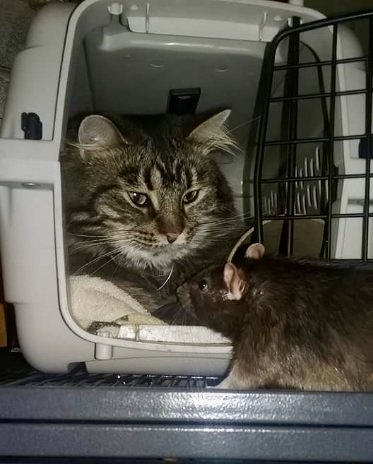
Tula, a very laid-back tabby mix housecat, and Leroy, a top-eared fancy rat, amicably share a home. Photographer: Misty Christo. Used with permission.
A trained dog or cat is also important. It should do what you say if you tell it to stop or leave it.
Before The First Introduction Of Critters With Dogs
Animals are very scent-based, so get them used to each others’ smells. Let your dog or cat smell an item that has been in your critter’s pen or cage.
Rub a towel on your dog or cat’s back several times then give it to your critter. Transfer scents from one to the other by rubbing a towel on one and rubbing the same towel on the other.
For the introduction, everyone (including you!) should be calm and relaxed. When we introduced Rylnn to the rabbits, we did so after taking her on a long walk so that she was tired. You could do this or play with your dog or cat beforehand.
A neutral spot for the introductions is also very important. It should ideally be in a place where they don’t eat, sleep, or potty in order to minimize territorial behavior.
One more note: cats should have their claws trimmed so that they don’t accidentally (or purposefully) give the rabbit a bad scratch.
The Distant Introduction
It helps to have two humans working with the pets! Allow your pets to see each other from a distance. You can hold your dog or cat while it watches your critter in its enclosure or you can hold or lightly restrain your critter while another human holds or restrains your cat or dog.
A dog should be on a leash at all times and preferably be wearing a harness instead of a collar (so that it doesn’t choke if you pull on the leash).
Let the animals get used to how the other one moves, smells and acts. Do this until they seem bored or don’t seem to care that the other is in the same room, possibly 20-30 minutes every day until they seem used to each other. Never leave critters with dogs alone, and if your critter starts to act frightened or stressed, end the session for the day.
If you are adopting a dog or cat and are “interviewing” several to see how they react to your critter, you can put the critter in its carrier. Make it comfortable with towels and treats!
When my husband and I adopted Laika after Rylnn passed away, we first brought the rabbits to the fosterer and allowed everyone to sniff each other through the open holes of the carrier. Laika whined and pawed at the carrier some, but she never barked or lunged at it (usually not good signs).
Getting Up Close And Personal
Once your dog or cat and critter are calm at a distance, you can bring them closer. Have your dog or cat sit or lie down, maintain good control, and allow your critter to approach. This way, it will be less likely to run – and less likely to trigger your dog or cat to chase.
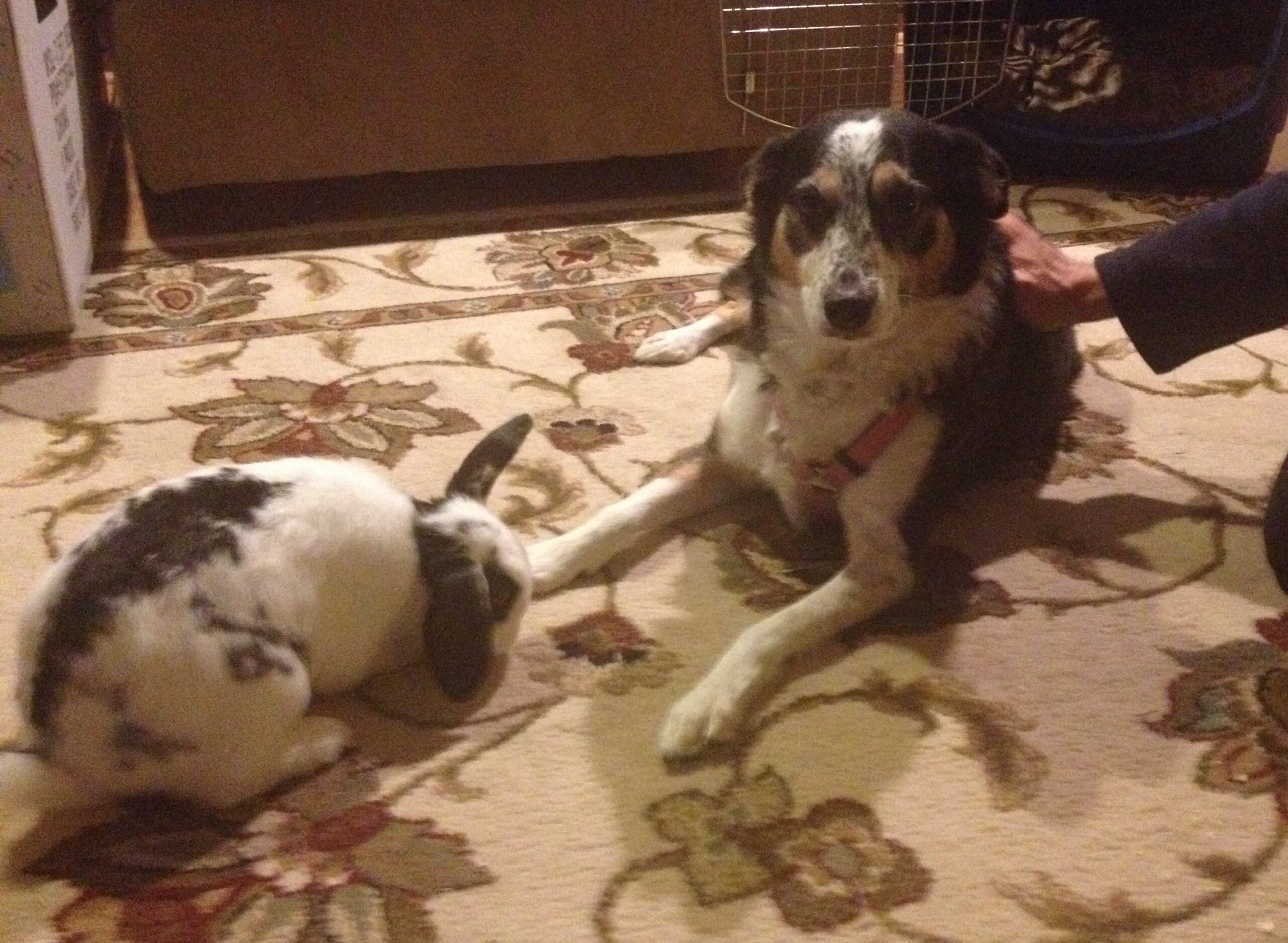
Rhett the rabbit is allowed to approach Rylynn the dog while Rylynn is controlled. Photographer: Amy “Brem” Bremers.
Talk softly, especially when telling your dog or cat to stop or stay, and never punish. Continue to monitor your critter’s stress level as you allow them to sniff each other up close.
If your dog or cat gets too excited or starts pawing, gently move it away from your critter. Reward positive behavior with treats! This will help them associate being together with good feelings.
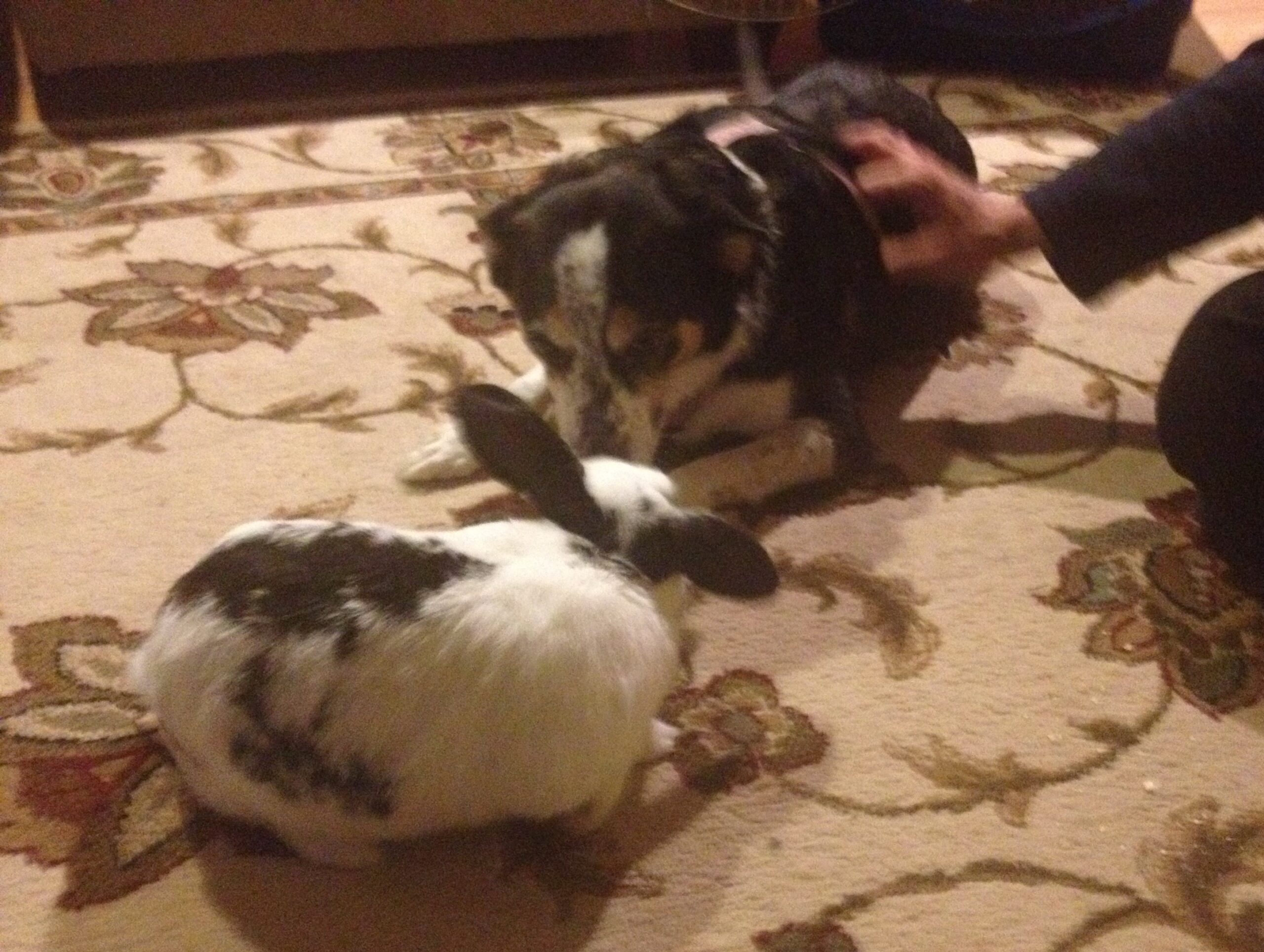
Rhett the rabbit and Rylynn the dog sniff each other while Rylynn is controlled. Photographer: Amy “Brem” Bremers.
During Laika’s first introduction, after about 15 minutes of being in their carrier, the rabbits were allowed to roam around the room while we held onto Laika.
After about another 15 minutes of them exploring and her watching them, my husband walked her close to them while I stayed ready to swoop in and “rescue” them if necessary.
We considered it a win that she sniffed their butts but didn’t do anything aggressive. (We quickly learned after bringing her home that she is a very passive dog – ideal for life with rabbits!)
Are They Bonded?
How will you know if your small pet and your larger pet are bonded? If your dog or cat does not get excited when it sees your critter move and if your critter can turn its back on your dog or cat or close its eyes, those are good signs.
Just remember that a lot of times they will never be actual friends; sometimes the best you’ll get when it comes to critters with dogs is mutual tolerance – but that’s how siblings sometimes are!
Copyright 2024 Amy “Brem” Bremers, DVM



